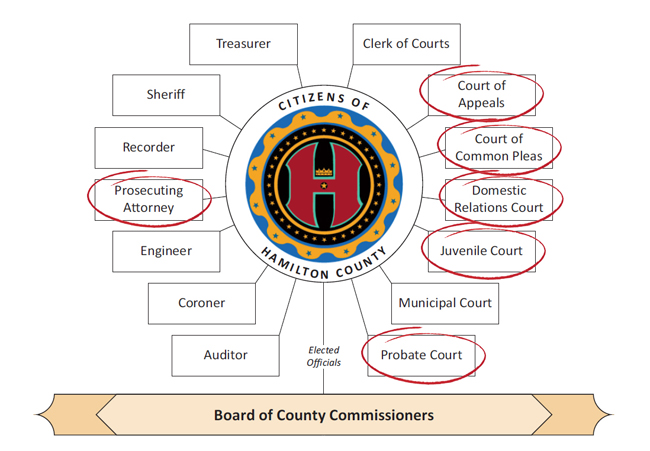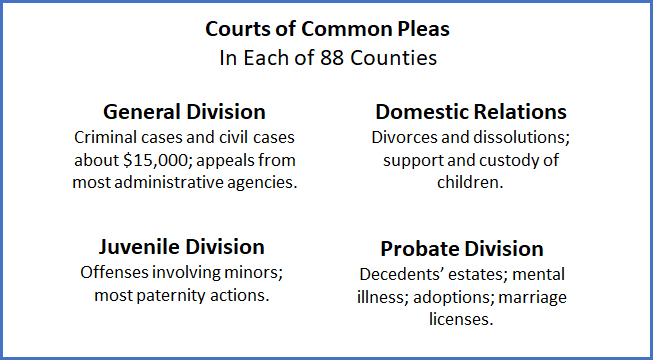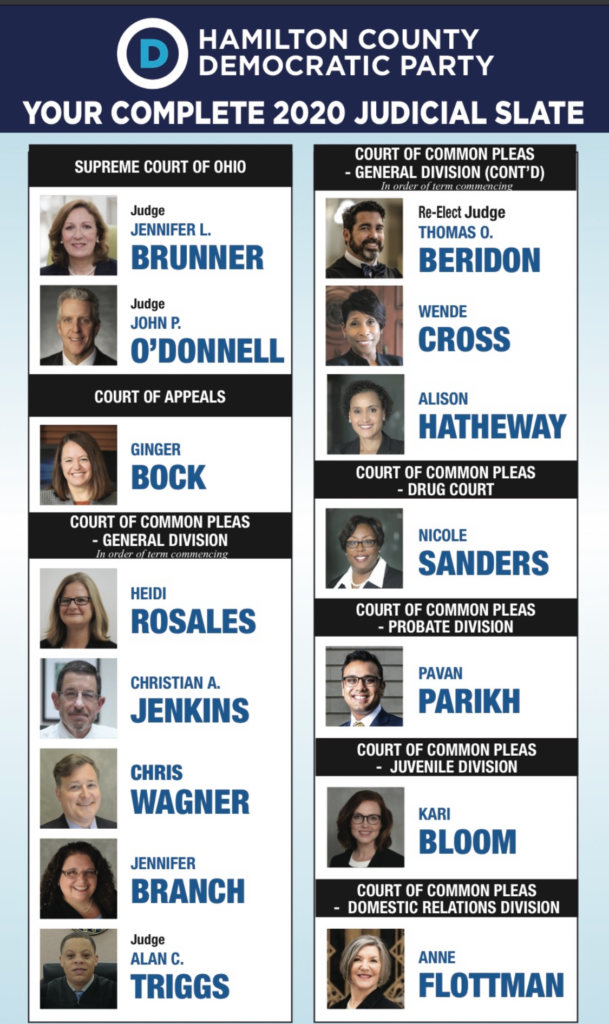Why judicial races matter to Black Lives Matter

1 in every 10 black men in their thirties is in prison or jail. Sentences for black men committing the same federal crime are 19.1 percent longer.
Why?
Many stages of the criminal justice system are behind these statistics. For instance, prosecutors decide what charges to bring and what sentences to recommend. Judges have the discretion to hand down sentences. Police officers make the initial bookings. Correction officers can discipline people in prison, which then plays into parole systems.
At every stage, these positions and the checks and balances on them matter because they have wide discretion over the decisions they make and how they interpret the law. These decisions can help people on the path towards rehabilitation or push them towards more punishment and incarceration.
Here, I’m going to use the example of Hamilton County, Ohio, because this is where I live. But you can do this for any county in America.
Let’s start by looking at the elected judicial positions in Hamilton County, their roles in the justice system and some ideas that would make the system fairer for everyone whether they’re black, white, or brown.

What does a district attorney do?
A district attorney, or DA, is the lawyer who prosecutes criminal cases for a particular county or district. District attorneys only prosecute violations of state laws. The U.S. Attorney’s office prosecutes under the Department of Justice prosecutes violations of federal law. Crimes can range from the serious, like murder, to lesser crimes like drug possession or vandalism. In some counties, district attorneys are simply called county prosecutors or prosecuting attorneys.
In Ohio, county district attorneys also act as legal advisors to the board of county commissioners, the board of elections, and all other county offices and boards.
District attorneys and their staff decide:
- Whether to charge someone for an offense (key when it comes to police brutality cases)
- What charges to file and what offenses to prosecute
- Whether or not to plea bargain with defendants
Why DAs matter
District attorneys wield immense power in our criminal justice system because they have the ability to determine when to prosecute and what charges to seek—if any.
And they have significant discretion. Even if they believe their efforts are fair, DAs may still be pursuing harsher sentences for black and brown people over white people in the case of similar crimes.
For example, a 2014 University of Michigan law school study found that at the federal level, black people receive sentences that are 10% longer than those of comparable whites arrested for the same crime. Most of this disparity was explained by the initial charging decisions of the prosecutors.
This can be remedied if a district attorney is willing to support evidence-based reforms. A change in DA can make a big difference. For example, when reform-minded Larry Krasner was elected DA in Philadelphia, he stopped prosecuting marijuana possession. Krasner also took a different approach regarding sentencing by starting plea bargaining at minimum levels instead of maximums. If defendants fear long sentences, sometimes they are willing to plead guilty in exchange for a lower sentence even if they’re not guilty.
Bail reform
Most jurisdictions in the U.S. rely upon some form of bail bond as a condition for pretrial release. Often this practice discriminates based on wealth and results in greater imprisonment for people of color.
According to a 2019 report on Bail reform by Harvard Law School:
On any given day, American jails imprison nearly half a million people who have not been convicted of a crime—many of whom remain in jail only because they cannot afford to pay for their release.
In Hamilton County, according to Hamilton County DA candidate Fanon Rucker, 65%-70% of people incarcerated in the justice center have not yet been convicted of any offense for which they’re charged. They’re just sitting in jail awaiting trial because they can’t afford bail.
Eliminating cash bail requirements for non-violent offenses would significantly reduce imprisonment based solely on poverty and inability to post bail.
What to look for in a district attorney
As John Pfaff, a professor of criminal law at Fordham University who studies mass incarceration, puts it:
“[Prosecutors] can choose how harshly to go after someone, how lenient to go after someone. They have tremendous power in that respect.”
From a social justice perspective, the District Attorney is the single most important position to change .
When considering who to vote for in the race for district attorney, look for candidates who openly advocate for social justice reforms like bail reform, not prosecuting marijuana possession or other minor crimes, and/or DAs who will purge the criminal records of those who have successfully completed probation.
Look for DA candidates who are willing to talk about the inequities in the justice system and who aren’t repeating “tough on crime” rhetoric.
In Hamilton County, the reform candidate is Fanon Rucker.

What does Ohio’s court system look like?
In Ohio, we have a state Supreme Court, 12 courts of appeals, and a county court system below the 12 courts of appeals called the court of common pleas.

Each county has a court of common pleas and this court is divided in 4 divisions: general, domestic relations, probate, and juvenile. The divisions handle:
- General – All criminal felony cases, all civil cases of amounts more than $15,000, and all cases involving title to real estate other than eviction.
- Domestic Relations – Divorces and dissolutions, domestic violence cases, parental support and custody of children.
- Probate – The probate of wills, adoptions, guardianship, mental illness cases, and the issuance of marriage licenses.
- Juvenile – Offenses involving minors, paternity cases, child support, and cases involving dependents.
There are also a number of courts with different jurisdictions like the municipal courts, mayors courts, and courts of claims. These courts handle misdemeanors, traffic tickets, and small civil claims below $15,000.
If you’d like to know more about Ohio’s court system, go here. To see the contact information for these offices in Hamilton County, you can go here.
Why do Ohio Supreme Court justices matter?
Before we look at county positions, let’s take a look at the Ohio Supreme Court because much of what they do and control greatly impacts our county justice systems.
The way to know for certain whether courts are making fair decisions regardless of race or sex is through the use of statistics.
Not only is it important that statistics be collected, but also that they be made public so there is transparency in the court system.
Ohio Chief Justice Maureen O’Connor has made it one of her goals to introduce data into the Ohio court system. In February 2019, Ohio unveiled a series of interactive dashboards showing data for all of Ohio’s courts of common pleas.
This is a giant step in the right direction because data can be used to evaluate decisions and compare different districts.
However, currently the system does not allow for searches or research on decisions based on race, sex, or other socioeconomic factors. This data, while often collected at the common pleas level, is still not available or accessible online.
To give you an example of the impact this could have, remember how I mentioned at the start of the article that black men face sentences 19.1% longer for the exact same crime? These kinds of sentencing disparities are likely going on at the state level as well. There’s just currently no insight because there’s no data.
The Ohio Supreme Court is composed of 7 justices. Currently, there is a 5-2 Republican majority. If Democratic candidates John O’Donnell and Jennifer Brunner win this November, the court will have a 4-3 Democratic majority.
If Democrats control the Ohio Supreme Court, they can push Ohio’s county court systems to collect and publish statistics on race. This sunlight on decisions would act as a check and balance on judges across Ohio and lead to more equitable sentencing.

Why do appellate court judges matter?
Next, let’s talk about the Ohio Court of Appeals or appellate court. Think of the court of appeals as the error correction court. The 1st District Court of Appeals represents Hamilton County.
Appellate courts consider appeals from all of the lower courts–all divisions of the common pleas court and municipal court. Litigants in Ohio are entitled to one appeal; as such, the twelve Courts of Appeals hear cases ranging from parking tickets to murder or multi-million dollar corporate cases. For most cases, the appeals process ends after being decided by one of the twelve Ohio appeals courts.
So why do appellate court justices matter?
First and most importantly, appellate courts matter because they set legal precedent for all courts within their jurisdiction. In the case of the 1st District Appellate Court, they’re setting legal precedent for every court in Hamilton County.
In other words, state laws can be interpreted in different ways. The courts decide how to interpret these laws largely through the appellate court system. Appellate courts interpret statutes and set precedent for both the lower courts and the appellate court itself.
Basically, lower courts in the district look to 1st District Court precedent when deciding cases.
From a social justice standpoint, it’s important to set good precedent for the 1st District and to have bad precedent challenged.
How to tell if an appellate court is doing its’ job
Second, it’s important to actively be setting precedent. This is what appellate courts do. They’re the error correction courts or courts of improvement. An appellate court should not be a rubber stamp. It’s supposed to look for and correct bad decisions. This is how the courts improve.
How can you tell if a court is setting precedent?
The way district courts set precedent is that they write what are called opinions. An opinion is when the court lays out its reasoning for the decision. Only cases with opinions can be used as precedent. The court does not always write opinions. Often cases are decided simply through a judgment entry. Judgment entries cannot be used as precedent and typically are also not considered for further appeal by the Ohio Supreme Court. Judgment entries are supposed to be for cases that don’t have merit.
If you compare the number of opinions a court writes, you can get a sense of how much that court influences precedent.
In 2017, the 1st District Appellate court only wrote full opinions for 20.2% of its case terminations. This was the lowest of all twelve Ohio district courts by far. The next closest was 40.3% and the average of all twelve courts was 55.3%.

The importance of statistics in appeals
Third, remember we talked about statistics.
Appellate attorneys can use demographic sentencing data to argue that a sentence was disproportionate to others in the same situation. Appellate judges may use this data to determine whether a defendant’s sentence was based on improper factors, such as race or sex. And although appellate judges do not sentence defendants, they can push for additional data driven changes at the state level.

Ginger Bock helped appeal a case like this:
“In 2018, I represented a young black man who received a sentence that was more than 60% above the federal sentencing guidelines. Transparent federal sentencing data helped me craft an argument that his sentence was disproportionate to other similarly situated defendants.”
For the 1st District Court of Appeals (Hamilton County), the reform candidate is Ginger Bock.
Why do the common pleas court judges matter?
Remember, there’s 4 types of common pleas courts in Ohio: General, Domestic Relations, Juvenile, and Probate Court.

From a social justice standpoint, it’s important that common pleas justices make fair, impartial decisions.
For instance, our juvenile court in Hamilton County can lean towards punishment or the court can lean towards rehabilitation. The courts can decide to move youths out of the juvenile court and send them to criminal court to be tried as adults. Other types of issues handled by the juvenile court include appointment of counsel, detention, and a determination of the need for additional services. There’s a great amount of discretion in terms of whether to advocate towards punishment or towards rehabilitation.
It’s critical that these decisions be fair and not based on race. Similarly this is true for other types of criminal cases in the general court, family decisions in the domestic relations court, and to a lesser extent in the probate court simply because race doesn’t tend to be as much of a factor.
When investigating which of these justices to vote for, look for judges who are willing to openly advocate for social justice in the judicial system. Look for judges who talk about diversity and the importance of courts looking like the people they represent.
Call to Action
Judicial races are crucial to Black Lives Matter because these positions have wide discretion in how they handle cases including when to bring charges, what charges to bring, hearing cases fairly, and sentencing.
The most important position is the district attorney position, but Supreme Court judges, appeals court judges and common pleas court judges also make a big difference. Look for judges and a district attorney who want to make criminal justice reform an issue. We know how to solve this and have solutions; we just must get better people in place.
In Hamilton County, Fanon Rucker is running for DA on a platform of criminal justice reform. Joe Deters, the current prosecutor, is emphasizing “law and order” (meaning the status quo).
The Democratic judicial candidates are running on a platform of social justice reform and would make a big difference to Black Lives Matter. Remember that for the judicial races, you won’t see the party of the candidate on your ballot. For this reason, I always download the Democratic slate card to take with me when voting.
In his first year after movement activists elected him DA, Philadephia’s Larry Krasner filed 6,500 fewer charges than in the previous year. We can see results like this in Hamilton County if we elect Fanon Rucker and reform-minded judges.
Get to know the candidates and vote the judicial races!











